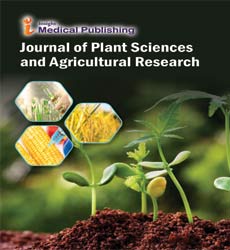Detection of Pesticide Residues and Selection of Agricultural Machinery for Precision Farming
Tariq Enebe*
Department of Agricultural Sciences, ETH Zurich, Zurich, Switzerland
- *Corresponding Author:
- Tariq Enebe
Department of Agricultural Sciences, ETH Zurich, Zurich,
Switzerland,
E-mail: enebet@gmail.com
Received date: November 25, 2024, Manuscript No. IPJPSAR-24-20184; Editor assigned date: November 27, 2024, PreQC No. IPJPSAR-24-20184 (PQ); Reviewed date: December 11, 2024, QC No. IPJPSAR-24-20184; Revised date: December 18, 2024, Manuscript No. IPJPSAR-24-20184 (R); Published date: December 25, 2024, DOI: 10.36648/ipjpsar.8.4.163
Citation: Enebe T (2024) Detection of Pesticide Residues and Selection of Agricultural Machinery for Precision Farming. J Plant Sci Agri Res Vol.8 No. 4: 163.
Description
The detection of pesticide residues in agricultural products is a critical aspect of food safety and environmental protection. Pesticides are widely used in modern agriculture to protect crops from pests, diseases and weeds, contributing to higher yields and better-quality produce. However, the use of pesticides raises concerns about the potential risks to human health, wildlife and the environment, particularly when pesticide residues remain on food products after harvest. As a result, monitoring pesticide residues in food is need to ensure that they are within safe limits and do not pose a threat to consumers.
Detection of pesticide residues in agricultural products
Pesticide residues are trace amounts of chemicals left on crops after pesticides have been applied during cultivation. These residues can persist on fruits, vegetables, grains and other crops and may be ingested by humans and animals. Regulatory agencies, such as the U.S. Environmental Protection Agency (EPA) and the European Food Safety Authority (EFSA), establish Maximum Residue Limits (MRLs) for pesticides in food, ensuring that residues remain within acceptable levels to protect public health. The detection and quantification of these residues are, therefore, important for food safety monitoring and regulatory compliance.
The detection of pesticide residues is typically carried out using sophisticated analytical techniques that can identify and quantify even trace amounts of chemicals. Common methods include chromatography techniques such as Gas Chromatography (GC) and Liquid Chromatography (LC), often coupled with Mass Spectrometry (MS) for high sensitivity and accuracy. These techniques allow for the separation and identification of individual pesticide compounds from complex food matrices. Another method is Enzyme-Linked Immuno-sorbent Assay (ELISA), which is a rapid and cost-effective screening tool for detecting specific pesticide residues. ELISA tests are particularly useful for on-site testing or for high-throughput analysis of samples.
The timing and method of pesticide application also influence the persistence of residues on crops. Factors such as the type of pesticide used, application rate, frequency of application and environmental conditions like temperature and rainfall can affect how long pesticide residues remain on crops. Therefore, monitoring pesticide residues throughout the production and post-harvest stages is need to ensure compliance with safety standards. In some cases, washing and peeling fruits and vegetables can help reduce pesticide residues, but this does not eliminate all traces, particularly when residues are present within the crop itself.
Selection of agricultural machinery for precision farming
Precision farming, also known as precision agriculture, is an innovative approach to farming that uses technology and datadriven decision-making to optimize crop production, minimize input use and increase sustainability. One of the key components of precision farming is the selection of appropriate agricultural machinery that can efficiently carry out specific tasks with high accuracy. The right machinery can help farmers reduce costs, improve productivity and minimize environmental impact.
The selection of agricultural machinery for precision farming depends on several factors, including the type of crops being grown, the scale of the operation and the specific farming practices being employed. In general, precision farming equipment includes machinery for planting, fertilizing, irrigating and harvesting crops, all of which are equipped with sensors, GPS systems and advanced software to monitor and control farming operations.
Tractors equipped with Global Positioning System (GPS) technology are among the most important machines in precision farming. GPS-guided tractors can follow predefined paths with high accuracy, reducing overlap and gaps in field operations. This increases efficiency and reduces the amount of seed, fertilizer and pesticide needed, leading to cost savings and reduced environmental impact. GPS-guided tractors can also be linked to other equipment, such as seeders, sprayers and harvesters, creating a fully integrated system that ensures precision and consistency throughout the farming process.
Another key component of precision farming machinery is the Variable Rate Technology (VRT) system, which enables the application of inputs like fertilizers and pesticides at variable rates depending on the specific needs of different areas within a field. This technology relies on data collected by sensors and other monitoring tools, such as soil sensors, satellite imagery and drones, to determine the optimal amount of inputs required. By using VRT, farmers can apply the right amount of fertilizer or pesticide precisely where it is needed, reducing waste and minimizing the environmental impact of excessive chemical use.
For pest and disease management, precision farming machinery includes sprayers that are equipped with advanced sensors and and automated systems. These sprayers can detect the presence of pests or disease in real-time and apply pesticides only in areas that require treatment, reducing pesticide use and minimizing exposure to non-target species. In addition, drones and autonomous vehicles are increasingly used in precision farming to monitor crop health and apply inputs more efficiently. Drones equipped with multispectral and thermal imaging cameras can capture detailed images of crops, identifying issues like pest infestations, nutrient deficiencies or water stress, which can be addressed with targeted treatments.
Open Access Journals
- Aquaculture & Veterinary Science
- Chemistry & Chemical Sciences
- Clinical Sciences
- Engineering
- General Science
- Genetics & Molecular Biology
- Health Care & Nursing
- Immunology & Microbiology
- Materials Science
- Mathematics & Physics
- Medical Sciences
- Neurology & Psychiatry
- Oncology & Cancer Science
- Pharmaceutical Sciences
